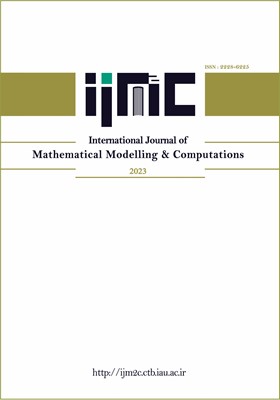Irrigation Water Resource Planning Optimization Model: The Case of Wine Grape Farming in Dodoma, Tanzania
Subject Areas : International Journal of Mathematical Modelling & Computations
Halidi Lyeme
1
*
![]() ,
JAIROS SHINZEH
2
,
JAIROS SHINZEH
2
1 - Department of Mathematics, Faculty of Science, Muslim University of Morogoro, P. O. Box 1031, Morogoro, Tanzania.
2 - Department of Mathematics and Statistics, College: Natural and Mathematical Sciences, The University of Dodoma, P.O.Box 338-Dodoma.
Keywords: linear programming, Optimization, Irrigation, MATLAB, FAO Penman-Monteith Equation,
Abstract :
Optimum cropping pattern in vineyard irrigated farming is one of the vital tasks for obtaining the best irrigation water reserves of the command. In this article the linear programming model was developed for optimal use of water and land resources. The model was tested by the data from Chinangali irrigated farmland with 120 cultivated hectares found in Dodoma, Tanzania. The results show that, the savings of 16 470.40 m3 of water per annum will be observed if the planting of 14.18 hectares of Chardonnay, 27.97 hectares of Cabernet sauvignon, 56.14 hectares of Riesling and 21.39 hectares of Chenin blanc. Thus, it was recommended that 1 173 359.60 m3 of water should be released to the irrigated farmland per annum for the best irrigation planning versus the 1 189 830 m3 of water supplied currently per annum.
[1] A. Abdulaziz, “A mathematical modelling approach for irrigation water management under water shortage and salinity conditions: the Wave_Ms model,” in Proc. Fourteenth International Water Technology Conference, 2010.
[2] M. C. Shrivastava, S., Verma, M., and Devatha, “Optimization Modelling For Crop Planning of Hasdeo Bango Command.,” Int. J. Eng., vol. 1, no. 9, 2012.
[3] M. Marcos, “Development of a model to optimize irrigation planning for multi-reservoir systems,” Concordia University, 1996.
[4] N. A. Kosolapova, L. G. Matveeva, A. Y. Nikitaeva, and L. Molapisi, “Modeling resource basis for social and economic development strategies: Water resource case,” J. Hydrol., vol. 553, 2017.
[5] R. A. Rwebugisa, “Groundwater recharge assessment in the Makutupora basin, Dodoma Tanzania,” in ITC, 2008.
[6] D. Seddon, J. J. Kashaigili, R. G. Taylor, M. O. Cuthbert, C. Mwihumbo, and A. M. MacDonald, “Focused groundwater recharge in a tropical dryland: Empirical evidence from central, semi-arid Tanzania,” J. Hydrol. Reg. Stud., vol. 37, 2021.
[7] R. G. Taylor et al., “Evidence of the dependence of groundwater resources on extreme rainfall in East Africa,” Nat. Clim. Chang., vol. 3, no. 4, 2013.
[8] E. Hajare, HV and Raman, NS and Dharkar, “New technique for evaluation of crop water requirement,” WSEAS Trans. Environ. Dev., vol. 5, no. 4, pp. 436–446, 2008.
[9] A. M. Michael, Irrigation Theory And Practice, Second Edi. Vikas publishing house, 2009.
[10] M. Todorović, “Crop Water Requirements and Irrigation Scheduling,” in Encyclopedia of Water, 2019.
[11] S. Tzimopoulos, C and Balioti, V and Evangelides, C and Yannopoulos, “Irrigation network planning using linear programming,” in Proceedings of the 12th International Conference on Environmental Science and Technology, Rhodes, Greece, 2011, pp. 8–10.
[12] A. AL-Omran, S. Eid, and F. Alshammari, “Crop water requirements of date palm based on actual applied water and Penman–Monteith calculations in Saudi Arabia,” Appl. Water Sci., vol. 9, no. 4, 2019.
[13] M. Smith, R. and Allen, and L. Pereira, “Revised FAO methodology for crop-water requirements,” At. Energy Agency, pp. 51–58, 1998.
[14] B. B. J. J. C. and F. P. A. and A. Camilo LT and Hedden-Dunkhorst, “Computational modeling for irrigated agriculture planning. Part I: General description and linear programming,” Eng. Agric., vol. 28, no. 3, pp. 471–482, 2008.
[15] P. E. Georgiou and D. M. Papamichail, “Optimization model of an irrigation reservoir for water allocation and crop planning under various weather conditions,” Irrig. Sci., vol. 26, no. 6, 2008.
[16] J. Adeyemo, JA and Otieno, FA and Ndiritu, “Differential evolution for optimizing irrigation water use,” in Proceedings of. 2008 Biennial Conference \& Exhibition, Sun City, South Africa, 2008.
[17] J. Adeyemo and F. Otieno, “Optimizing planting areas using differential evolution (DE) and linear programming (LP),” Int. J. Phys. Sci., vol. 4, no. 4, 2009.
[18] H. Sankhayan, PL and Cheema, “Using linear programming models for generating optimum farm plans-an expository analysis,” Indian J. Agric. Econ., vol. 46, no. 902-2018–2876, pp. 601–612, 1991.
[19] J. Williams, LE and Ayars, “Grapevine water use and the crop coefficient are linear functions of the shaded area measured beneath the canopy,” Agric. For. Meteorol., vol. 132, no. 3–4, pp. 201–211, 2005.
[20] A. Geletu, “Solving Optimization Problems using the Matlab Optimization Toolbox - a Tutorial,” Math. Program., vol. 43, 2007.

